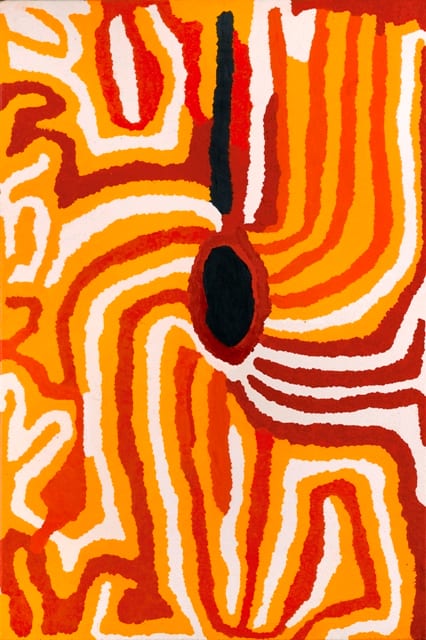Lucy Yukenbarri Napanangka Aboriginal, 1934-2002
A Soakage in Sandhill Country, 1997
Acrylic on canvas
178 x 119 cm
Warlayirti Artists no. 449/97
Lucy Yukenbarri comes from country that extends along the area in the Great Sandy Desert now known as the Canning Stock Route to Jupiter Well and Well 33. This includes...
Lucy Yukenbarri comes from country that extends along the area in the Great Sandy Desert now known as the Canning Stock Route to Jupiter Well and Well 33. This includes such sites as Marpa, Piyulpa, Winpupulla and Wirtjinti. The Oxford Companion to Aboriginal Art and Culture states: 'Yukenbarri is known among the Balgo artists for having invented a new style of dotting called kinti-kinti (close-close) in 1990 soon after she began to paint. Her early works followed the standard Balgo methods of forming lines by means of rows of dotting and of outlining icons in a similar way. A quietly creative artist, she then moved to another technique in use by other Balgo painters at the time - single colour fields of dotting - but she alone made a next step of moving the dots so closely together that they converged, creating dense masses of pigment on the surface of the canvas. This, together with her exploration of the visible possibilities of black icons for waterholes and soaks, and her use of dark green and blue pigments, gave her work a distinctive style, producing effects unique in desert Aboriginal art.'
Lucy's paintings are fully informed by her Marpa country. This is important women's country, which is shown throughout her painting, coming here for ceremony. The dot work throughout her painting represents some of the food available at Marpa, in particular, kantilli or bush raisin. The desert oak, or kurkapi, is also found here and depicted as the three solid bands of colour. The majority of the painting depicts tali or sand dunes which dominate the landscape of the area.
Yukenbarri's husband is Helicopter Tjungurrayi who is also a Warlayirti artist. Together they had eight children, two of which are artists in their own right.
Collections
ArtBank, Sydney
Berndt Museum of Anthropology, University of Queensland
Campbelltown City Art Gallery
National Gallery of Australia
National Gallery of Victoria
The Holmes a Court Collection
Laverty Collection
Kluge Ruhe Collection, USA
Parliament House Art Collection
Alice Springs Art Foundation, Araluen Centre
Ken Thompson and Pierre Marecaux Collection
Lucy's paintings are fully informed by her Marpa country. This is important women's country, which is shown throughout her painting, coming here for ceremony. The dot work throughout her painting represents some of the food available at Marpa, in particular, kantilli or bush raisin. The desert oak, or kurkapi, is also found here and depicted as the three solid bands of colour. The majority of the painting depicts tali or sand dunes which dominate the landscape of the area.
Yukenbarri's husband is Helicopter Tjungurrayi who is also a Warlayirti artist. Together they had eight children, two of which are artists in their own right.
Collections
ArtBank, Sydney
Berndt Museum of Anthropology, University of Queensland
Campbelltown City Art Gallery
National Gallery of Australia
National Gallery of Victoria
The Holmes a Court Collection
Laverty Collection
Kluge Ruhe Collection, USA
Parliament House Art Collection
Alice Springs Art Foundation, Araluen Centre
Ken Thompson and Pierre Marecaux Collection
Provenance
Warlayirti Artists, Balgo Hills
Exhibitions
2009, Wangkartu Dreaming: Helicopter Tjungurrayi & Lucy Yukenbarri, Whiford Fine Art, London
Literature
Wangkartu Dreaming: Helicopter Tjungurrayi & Lucy Yukenbarri, Whiford Fine Art, London, 2009, exhibition catalogue, ill. cat. no.10
Join our mailing list
* denotes required fields
In order to respond to your enquiry, we will process the personal data you have supplied in accordance with our privacy policy (available on request). You can unsubscribe or change your preferences at any time by clicking the link in any emails.
